Editor’s Note - In this article written for TAC News, Jon Lewis, Traffic Engineer, Engineering Services Division, City of Fredericton, writes about tracking driver behaviour at the first multi-lane roundabout in Fredericton. Prepared on behalf of TAC’s Small Municipalities Task Force, this article is part of a series of feature articles on the issues and challenges affecting smaller communities.
Look up! Look way up! The City of Fredericton’s Engineering Services Division is working with the University of New Brunswick (UNB) Transportation Group to track driver behaviour at the new Route 8 / Smythe Street multi-lane roundabout.

Photo provided by: UNB Transportation Group
Single-lane roundabouts have been operating successfully in Fredericton since 2010; however, the Route 8 / Smythe Street roundabout will be Fredericton’s first multi-lane roundabout so it is important that local drivers understand how to drive at this type of intersection.
A Q & A webpage was developed by the City of Fredericton to help answer the most common questions on roundabouts. This section also includes a visual map to explain how to get around; explanations on roundabout road signage; a series of roundabout videos including how to help navigate motorists, pedestrians and cyclists, and benefits of roundabouts.
This first modern multi-lane roundabout constructed in New Brunswick opened in September 2015 and accommodates over 27,000 vehicles per day. Prior to opening, there was substantial public concern regarding whether local drivers would be able to learn how to drive a multi-lane roundabout correctly.
Using Aerial Drone Technology
Aerial drones, flown at 150 metres above the roundabout, have been collecting video data every month since opening to track how drivers are navigating the roundabout and to determine what errors, if any, they are making. A UNB engineering student in construction engineering is flying the drone, while a transportation engineering student is analyzing the video.
The analysis of the video is showing that driver behaviour has been improving steadily since the roundabout opened and that the vast majority of motorists are now using the roundabout properly. The one common driver error that remains is that when vehicles enter the roundabout they must yield to both lanes inside the circle. This information has helped the City of Fredericton focus public education efforts on the most common driver errors observed.
There will be a major construction project on an adjacent arterial route in Fredericton during the summer of 2016. This is anticipated to push roundabout traffic volumes above predicted capacities during peak periods. Drone video will be collected during saturated flow conditions in order to evaluate how effective roundabout capacity models are in predicting actual capacity in a Canadian context. The research being completed with the collected video will be shared with other municipalities considering implementing similar type facilities. The use of aerial drones has been an incredibly useful way to collect video data of driver behaviour that would not have otherwise been possible.
For additional information or questions, contact Jon Lewis, Traffic Engineer, City of Fredericton.